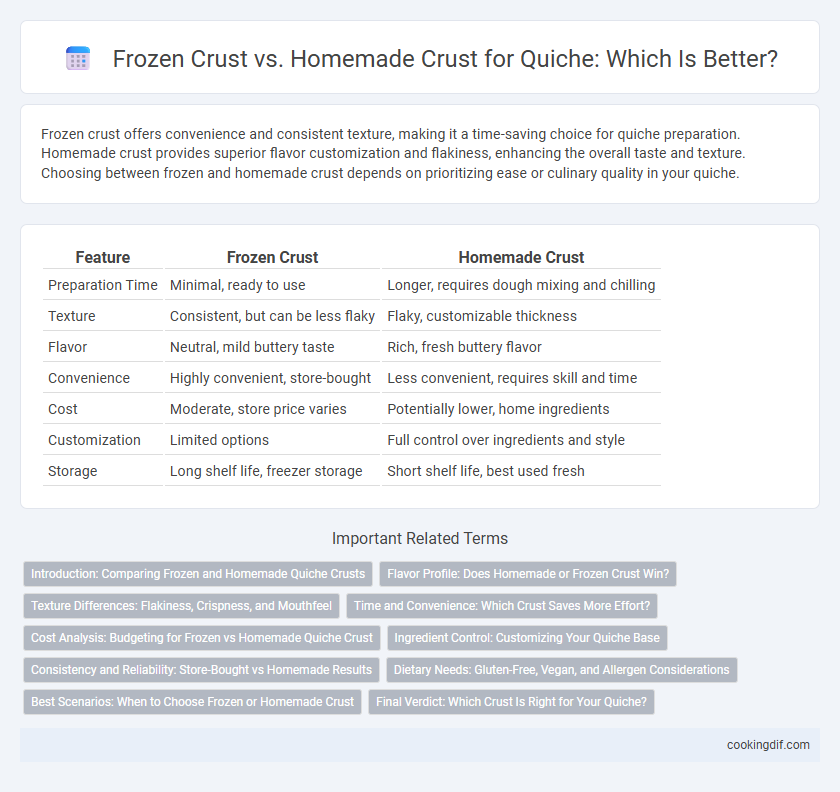Frozen crust offers convenience and consistent texture, making it a time-saving choice for quiche preparation. Homemade crust provides superior flavor customization and flakiness, enhancing the overall taste and texture. Choosing between frozen and homemade crust depends on prioritizing ease or culinary quality in your quiche.
Table of Comparison
| Feature | Frozen Crust | Homemade Crust |
|---|---|---|
| Preparation Time | Minimal, ready to use | Longer, requires dough mixing and chilling |
| Texture | Consistent, but can be less flaky | Flaky, customizable thickness |
| Flavor | Neutral, mild buttery taste | Rich, fresh buttery flavor |
| Convenience | Highly convenient, store-bought | Less convenient, requires skill and time |
| Cost | Moderate, store price varies | Potentially lower, home ingredients |
| Customization | Limited options | Full control over ingredients and style |
| Storage | Long shelf life, freezer storage | Short shelf life, best used fresh |
Introduction: Comparing Frozen and Homemade Quiche Crusts
Frozen quiche crusts offer convenient time-saving benefits with consistent texture and easy preparation, making them ideal for quick meals or busy schedules. Homemade crusts provide superior flavor and customizable thickness, allowing control over ingredients such as butter and flour for a richer, flakier result. Choosing between frozen and homemade crusts depends on priorities like taste preference, convenience, and preparation time.
Flavor Profile: Does Homemade or Frozen Crust Win?
Homemade quiche crust offers a richer, buttery flavor with a flaky texture that enhances the overall taste experience, thanks to fresh ingredients and precise control over thickness and browning. Frozen crusts often contain preservatives and stabilizers, which can dull flavor and result in a less crisp bite, although they provide consistent convenience and uniformity. For a truly flavorful quiche, homemade crust typically outperforms frozen options by delivering superior texture and a deeper, more complex taste profile.
Texture Differences: Flakiness, Crispness, and Mouthfeel
Frozen quiche crusts offer consistent flakiness and crispness due to industrial chilling and controlled fat distribution, resulting in a uniform texture that holds up well during baking. Homemade crusts provide variable flakiness depending on the butter-to-flour ratio and handling, often yielding a tender, buttery mouthfeel that can range from delicate to slightly dense. Texture differences between frozen and homemade crusts significantly impact the overall sensory experience, with frozen crusts emphasizing crispness and homemade versions favoring a richer, melt-in-the-mouth sensation.
Time and Convenience: Which Crust Saves More Effort?
Frozen crust significantly saves time and effort by eliminating the need for dough preparation, rolling, and chilling, making it ideal for quick quiche assembly. Homemade crust requires more hands-on work, including mixing, resting, and shaping, which can be time-consuming but offers greater control over texture and flavor. For maximum convenience and efficiency, frozen crust is the preferred choice in busy kitchens or when under time constraints.
Cost Analysis: Budgeting for Frozen vs Homemade Quiche Crust
Frozen quiche crust typically costs between $2 and $5 per package, offering convenience without the need for additional ingredients or preparation time. Homemade crust ingredients such as flour, butter, and salt generally cost around $1 to $3 per batch, but require extra time and skill for preparation, which can influence the overall budget. Choosing between frozen and homemade quiche crust depends on weighing ingredient costs against time investment and desired quality in the final product.
Ingredient Control: Customizing Your Quiche Base
Homemade quiche crust offers precise ingredient control, allowing you to tailor the flour type, fat content, and seasoning to suit dietary preferences and enhance flavor profiles. Frozen crusts often contain preservatives, stabilizers, and added salt, limiting customization and potentially impacting the quiche's texture and taste. Opting for a homemade base enables customization of crust thickness and ingredient quality, directly influencing the overall nutritional value and sensory experience of your quiche.
Consistency and Reliability: Store-Bought vs Homemade Results
Frozen quiche crusts provide consistent thickness and texture, ensuring uniform baking results that save time and reduce preparation variability. Homemade crusts offer greater control over flavor and ingredient quality but often yield inconsistent thickness and baking outcomes depending on technique and experience. Choosing between frozen and homemade crusts depends on balancing reliable, repeatable results with personalized taste preferences for quiche dishes.
Dietary Needs: Gluten-Free, Vegan, and Allergen Considerations
Frozen crust options often include gluten-free and vegan varieties that cater to specific dietary needs, offering a convenient choice for those with allergies or sensitivities. Homemade crusts provide control over ingredients, allowing customization for gluten-free flours, vegan fats, and allergen-free substitutes to better manage dietary restrictions. Selecting crusts based on ingredient transparency and dietary compatibility ensures a quiche that meets gluten-free, vegan, and allergen-conscious requirements effectively.
Best Scenarios: When to Choose Frozen or Homemade Crust
Frozen crusts provide consistent texture and convenience, ideal for quick meal preparation or busy schedules when time is limited. Homemade crusts offer superior flavor customization and flakiness, making them perfect for special occasions or when ingredient control is essential. Choosing frozen crust suits last-minute dinners, while homemade crust excels in gourmet quiche recipes requiring a personalized touch.
Final Verdict: Which Crust Is Right for Your Quiche?
Frozen crust offers convenience and consistent texture, making it ideal for busy cooks seeking a reliable base for their quiche. Homemade crust provides superior flavor customization and flaky texture, perfect for those wanting a personalized, artisanal touch. Choose frozen crust for speed and ease, or homemade crust for a richer, more handcrafted quiche experience.
Frozen crust vs homemade crust for quiche Infographic

 cookingdif.com
cookingdif.com